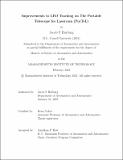Improvements to LEO Tracking on The Portable Telescope for Lasercom (PorTeL)
Author(s)
Harburg, Jacob F.
DownloadThesis PDF (1.504Mb)
Advisor
Cahoy, Kerri
Terms of use
Metadata
Show full item recordAbstract
Small satellites are getting more advanced and generating more data. This has put a strain on their communications systems. Laser communications can offer higher bandwidth at the same size, weight, and power (SWaP) as conventional radio frequency (RF) communications. Laser communications also avoid the strict spectrum regulation which RF communications must comply with. These factors make laser communications particularly advantageous for small satellites.
Laser communications can outperform RF communications due to the higher carrier frequency and subsequent narrower beams. These narrower beams, however, impose strict pointing requirements between transmitters and receivers. Another issue that that laser communications must contend with is weather. The optical wavelengths used in laser communications are heavily attenuated by clouds. This can be a significant problem as cloud cover can render ground stations inoperable. This motivates the need for a network of affordable and portable ground stations that can be easily redeployed to respond to changing weather conditions.
The Portable Telescope for Lasercom (PorTeL) is an optical ground station that was developed at MIT to address the need for affordable and portable ground stations. PorTeL was designed using a low cost commercial off-the-shelf (COTS) architecture. This thesis focuses on updates made to PorTeL to enable it to receive optical downlinks from the CubeSat Laser Infrared CrosslinK (CLICK) mission satellites in low-Earth orbit (LEO). We show that PorTeL is able to track CLICK-A with an accuracy of 11.1 arcseconds, well within its requirement of 21.8 arcseconds.
Date issued
2023-02Department
Massachusetts Institute of Technology. Department of Aeronautics and AstronauticsPublisher
Massachusetts Institute of Technology